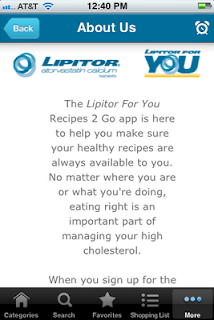I wrote about that only because it was the first time -- to my knowledge -- that a pharma corporate blog promoted a branded product and I wondered if such posts violated AZ's own posting policies (turns out that it may or may not depending upon what you mean by "may" -- see the post for details).
Today, I noticed an AZ Health Connections blog post that talked about another AZ drug - ARIMIDEX, which is approved for "adjuvant treatment (treatment following surgery with or without radiation) of postmenopausal women with hormone receptor-positive early breast cancer."
This time, however, the post (find it here; see screen capture above) did NOT mention the approved indication. It is, by FDA definition, a "reminder ad." According to the Pharma Marketing Network Glossary:
Reminder advertisements are identified as an exemption to the advertisement regulations, including provisions to provide a brief summary. Reminder advertisements " . . . call attention to the name of the drug product but do not include indications or dosage recommendations for use of the drug product. . . . and, optionally, information . . . containing no representation or suggestion relating to the advertised drug product." Reminder advertisements cannot make a representation about the product or suggest a use for the product.The AZ Health Connections post does "call attention to the name of the drug," but it also directs readers to ARIMIDEX Direct, which is a program that "allows eligible patients to receive ARIMIDEX delivered to their homes for $40 a month, including shipping and handling." Sounds like a good deal, although I did not investigate what the eligibility requirements were.
AZ deserves credit for reaching out to the online community to learn more about how it can make its drugs more accessible. Recall that AZ was the first pharma company to host a Twitter chat "to raise awareness about helping patients save money through prescription savings programs" (see "OMG! AstraZeneca Hosts Twitter Chat & World Does NOT End!").
PhRMA "forbids" Reminder Ads, But Not on Internet!
AZ's post raises some interesting questions regarding the promotion of Rx drugs on the Internet that neither the FDA nor the pharma industry has addressed. For example, PhRMA's "Guiding Principles for Direct-to-Consumer Advertising" (here) prohibit reminder ads on TV but NOT on the Internet:
Principle #10: "DTC television advertising that identifies a product by name should clearly state the health conditions for which the medicine is approved and the major risks associated with the medicine being advertised." [Alos see "Reminder Ads - Pharma's Dodo?"]AZ, I believe, is a signatory to these voluntary guidelines. Since these guidelines only apply to TV advertising, AZ is not in violation. It's still the "wild west" on the Internet with regard to reminder ads; i.e., It's perfectly fine to run "reminder ads" on the Internet. This is usually the case when pharma companies buy Adwords (paid search ads) from Google, especially after the FDA came down on Adwords that included the indication with the brand name.
Another interesting issue is how pharma companies can manipulate "natural" (aka "organic") Google search results to display what is essentially a branded product ad that includes the brand name and indication, but no ISI.
Search Google for "arimidex" as I just did and you will find this:
The #4 (or #3, depending on how you count) search result leads you to the home page of the www.arimidex.com Web site. Note that the search result looks like an ad with copy that mentions the indication of the drug: "Learn about IN YOUR CORNER, an online breast cancer support resource for women with early breast cancer and the people who care about them."
How did that copy get there? Simple, AZ included the following "meta tags" in the "header" of the HTML code that generates the home page:
Google mindlessly reads the META NAME tag to display the description of the site in the search result. The information contained in that tag, of course, was written by AZ with the full realization that a Google search will include it in the search result. From there, it is only necessary to ensure that the site gets good placement in the natural results list and BINGO! You've got a branded "ad" that mentions the drug name and the indication WITHOUT the required ISI.
P.S. The Arimidex search result shown above may actually be what's called "paid inclusion," which refers to a sponsored "organic" search result (see, for example, "Paid Inclusion: Too Hot for Pharma Marketing?").


























